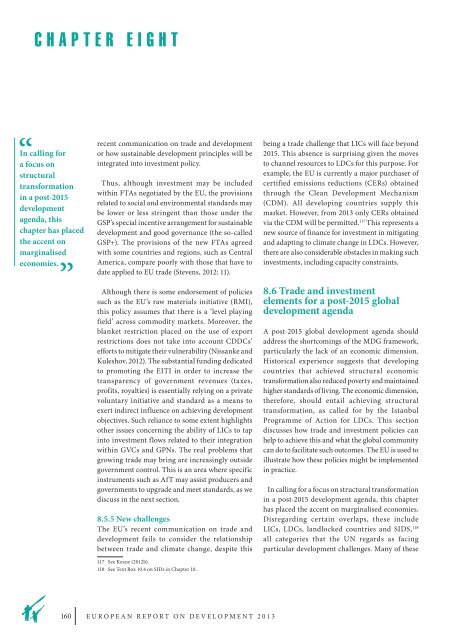Post 2015: Global Action for an Inclusive and Sustainable Future
Post 2015: Global Action for an Inclusive and Sustainable Future
Post 2015: Global Action for an Inclusive and Sustainable Future
You also want an ePaper? Increase the reach of your titles
YUMPU automatically turns print PDFs into web optimized ePapers that Google loves.
CHApTER EIgHT<br />
In calling <strong>for</strong><br />
a focus on<br />
structural<br />
tr<strong>an</strong>s<strong>for</strong>mation<br />
in a post-<strong>2015</strong><br />
development<br />
agenda, this<br />
chapter has placed<br />
the accent on<br />
marginalised<br />
economies.<br />
160<br />
recent communication on trade <strong>an</strong>d development<br />
or how sustainable development principles will be<br />
integrated into investment policy.<br />
thus, although investment may be included<br />
within Ftas negotiated by the Eu, the provisions<br />
related to social <strong>an</strong>d environmental st<strong>an</strong>dards may<br />
be lower or less stringent th<strong>an</strong> those under the<br />
GSp’s special incentive arr<strong>an</strong>gement <strong>for</strong> sustainable<br />
development <strong>an</strong>d good govern<strong>an</strong>ce (the so-called<br />
GSp+). the provisions of the new Ftas agreed<br />
with some countries <strong>an</strong>d regions, such as central<br />
america, compare poorly with those that have to<br />
date applied to Eu trade (Stevens, 2012: 11).<br />
although there is some endorsement of policies<br />
such as the Eu’s raw materials initiative (rmI),<br />
this policy assumes that there is a ’level playing<br />
field’ across commodity markets. moreover, the<br />
bl<strong>an</strong>ket restriction placed on the use of export<br />
restrictions does not take into account cDDcs’<br />
ef<strong>for</strong>ts to mitigate their vulnerability (niss<strong>an</strong>ke <strong>an</strong>d<br />
Kuleshov, 2012). the subst<strong>an</strong>tial funding dedicated<br />
to promoting the EItI in order to increase the<br />
tr<strong>an</strong>sparency of government revenues (taxes,<br />
profits, royalties) is essentially relying on a private<br />
voluntary initiative <strong>an</strong>d st<strong>an</strong>dard as a me<strong>an</strong>s to<br />
exert indirect influence on achieving development<br />
objectives. Such reli<strong>an</strong>ce to some extent highlights<br />
other issues concerning the ability of lIcs to tap<br />
into investment flows related to their integration<br />
within Gvcs <strong>an</strong>d Gpns. the real problems that<br />
growing trade may bring are increasingly outside<br />
government control. this is <strong>an</strong> area where specific<br />
instruments such as aft may assist producers <strong>an</strong>d<br />
governments to upgrade <strong>an</strong>d meet st<strong>an</strong>dards, as we<br />
discuss in the next section.<br />
8.5.5 New challenges<br />
the Eu’s recent communication on trade <strong>an</strong>d<br />
development fails to consider the relationship<br />
between trade <strong>an</strong>d climate ch<strong>an</strong>ge, despite this<br />
117 See Ke<strong>an</strong>e (2012b).<br />
118 See text box 10.4 on SIDs in chapter 10.<br />
EuropE<strong>an</strong> rEport on DEvElopmEnt 2013<br />
being a trade challenge that lIcs will face beyond<br />
<strong>2015</strong>. this absence is surprising given the moves<br />
to ch<strong>an</strong>nel resources to lDcs <strong>for</strong> this purpose. For<br />
example, the Eu is currently a major purchaser of<br />
certified emissions reductions (cErs) obtained<br />
through the cle<strong>an</strong> Development mech<strong>an</strong>ism<br />
(cDm). all developing countries supply this<br />
market. However, from 2013 only cErs obtained<br />
via the cDm will be permitted. 117 this represents a<br />
new source of fin<strong>an</strong>ce <strong>for</strong> investment in mitigating<br />
<strong>an</strong>d adapting to climate ch<strong>an</strong>ge in lDcs. However,<br />
there are also considerable obstacles in making such<br />
investments, including capacity constraints.<br />
8.6 Trade <strong>an</strong>d investment<br />
elements <strong>for</strong> a post-<strong>2015</strong> global<br />
development agenda<br />
a post-<strong>2015</strong> global development agenda should<br />
address the shortcomings of the mDG framework,<br />
particularly the lack of <strong>an</strong> economic dimension.<br />
Historical experience suggests that developing<br />
countries that achieved structural economic<br />
tr<strong>an</strong>s<strong>for</strong>mation also reduced poverty <strong>an</strong>d maintained<br />
higher st<strong>an</strong>dards of living. the economic dimension,<br />
there<strong>for</strong>e, should entail achieving structural<br />
tr<strong>an</strong>s<strong>for</strong>mation, as called <strong>for</strong> by the Ist<strong>an</strong>bul<br />
programme of action <strong>for</strong> lDcs. this section<br />
discusses how trade <strong>an</strong>d investment policies c<strong>an</strong><br />
help to achieve this <strong>an</strong>d what the global community<br />
c<strong>an</strong> do to facilitate such outcomes. the Eu is used to<br />
illustrate how these policies might be implemented<br />
in practice.<br />
In calling <strong>for</strong> a focus on structural tr<strong>an</strong>s<strong>for</strong>mation<br />
in a post-<strong>2015</strong> development agenda, this chapter<br />
has placed the accent on marginalised economies.<br />
Disregarding certain overlaps, these include<br />
lIcs, lDcs, l<strong>an</strong>dlocked countries <strong>an</strong>d SIDS, 118<br />
all categories that the un regards as facing<br />
particular development challenges. m<strong>an</strong>y of these

















